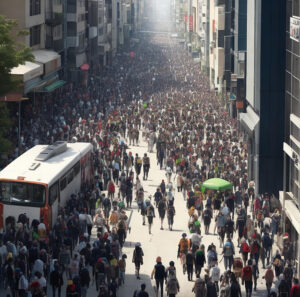TRAVEL
Canada Temporary Foreign Worker Visas: How to Obtain a Work Permit In Canada

Canada Temporary Foreign Worker Visas: How to Obtain a Work Permit In Canada
Canada Temporary Foreign Worker Visas. Because of its advanced economy, Canada offers a diverse range of job options and competitive pay. Many people from other countries would want to go there because of the abundance of decent employment opportunities. The Canadian government knows this, which is why they created work permits.
A valid Canadian work permit is required to seek employment or enter into a contract for work in Canada. When applying for a Canadian visa, you’ll also need to get a work permit. When you apply for a visa, the Consular Office will also process your application for a work permit simultaneously.
For those who want to work in Canada, there are two options:
There are two ways through which you can get a Canada work permit:
- Via Temporary Work Visas
- Via Permanent or Immigrant Work Visas
For the first category of visas, you may be a temporary worker in Canada for a period of six months or less. Those who have secured employment in Canada qualify for the second category of visas. In this piece, we’ll take a high-level look at temporary work visas.
How Do Temporary Work Visas to Canada Work?
An individual needs both a Temporary Resident Visa and a Work Permit in order to legally work in Canada, which is why the country offers a Temporary Work Visa.
Read also: https://financialquest.com.ng/10-best-business-schools-in-canada-with-scholarships/
You may remain in Canada for up to 6 months with a Temporary Resident Visa (TRV), and you can work in the job you’ve already found or hunt for employment with a Work Permit for Canada.
Unfortunately, depending on the sort of visa you hold, your ability to work in Canada may expire in a matter of months or years. This implies that you will have the option of applying to have your Canadian work visa extended or returning to your native country after it has expired.
Your total temporary work authorization in Canada cannot exceed 4 years, including any extensions. This may or may not be the case for you, however, depending on your place of origin and the kind of visa you possess.
If your Canadian work visa expires, you will be deported if you continue to live and work in the country. This effectively disqualifies you from ever obtaining another Canadian visa.
Who Requires a Canadian Temporary Work Permit?
A Temporary Work Visa or Work Permit is required for entry into Canada for the purpose of gaining employment and subsequently earning a wage. If you’re not doing any of the following, you don’t require a work permit:
- You will get your salary from a company that is registered in Canada as a business.
- Your primary location of work will be Canada.
- Your intention is to become employed in Canada with a salary.
- Your salary will be paid to you and deposited in a Canadian bank account
However, a work visa is not required if your employer is located outside of Canada and your stay in the nation is temporary.
Those who may not need a Canadian work permit are the following groups of visitors:
- Business visitors.
- Performing artists.
- Athletes and their team members.
- Judges, referees, or similar workers.
- Media crews and news reporters.
- Foreign Government Workers.
- Foreign Government Representatives and their family members.
- Military personnel.
- Health care students.
- Students who are working on campus.
- Public speakers and convention organizers.
- Evaluators and examiners.
- Clergy.
- Civil aviation inspectors.
- Aviation accident inspectors.
- Emergency service providers.
- Expert witnesses and investigators.
- Researchers who have to work in Canada for 120 days only.
Can I Get a Work Permit and Visa to Come to Canada?
The following are the requirements that all applicants must meet in order to be considered for a Canada work visa in order to be able to work in Canada temporarily:
- Prove that you have the intent to depart Canada and return to your native country when your work visa expires.
- Always adhere to the terms of your work visa, whether they are open and enable you to work for any business or particular and restrict you to working for just one;
- Document that you will not accept employment with a company that offers illegal services, such as erotic dancing, striptease, escorting, or massages for the sexually exploited.
Work permit and visa applications made from outside of Canada (i.e., the applicant’s home country) must also meet the criteria for a Temporary Visa.
If you are applying from inside Canada, however, you must additionally meet the following criteria for a Canadian work permit:
- You are already a refugee or protected person.
- You are currently in Canada with a study permit or you have a work permit that will expire soon.
- A graduate of a school in Canada.
- Gave a temporary resident permit that is valid for 6 or more months.
- Applied for refugee status in Canada and are waiting for a decision.
- Your application for refugee status has been denied but you cannot leave Canada for reasons beyond your control;
How to Get a Work Permit in Canada Temporarily.
The following is a summary of the procedures involved in obtaining a work visa for Canada:
- Find a short-term position with a firm in Canada.
- An employment offer from a Canadian company is often required when applying for a work visa.
- If you are planning to work in Canada on an Open Work Permit, you will be able to change jobs and locate a new employer once you arrive. A job offer is required before applying for an employer-specific work visa.
In order to qualify for Canada’s Foreign Temporary Workers Visa, you must first secure employment in Canada before leaving your native country.
You may skip this stage if your only purpose for visiting Canada is to apply for a job. Knowing where you intend to work increases your chances of being granted a working holiday visa.
To aid you in your job hunt in Canada, there are several internet services available. To locate a job in Canada, you may either look at various websites or use a head hunting agency. In any case, you won’t be able to apply for a work visa until you get an offer of temporary employment from the prospective employer.
The company you will work for must have a LMIA
After securing a job, the firm that is willing to employ you must submit an LMIA application to the Canadian government. Legally, a firm may only engage temporary foreign workers if it has been granted an LMIA, which is issued by the government.
You can’t just walk into a job in Canada without the hiring firm applying for the proper visa and showing that hiring you won’t hurt the employment prospects of Canadian citizens and permanent residents. They have the burden of proving that no Canadians are willing, competent, or qualified to fill the post before they may recruit foreign nationals. You can’t apply for a work visa in Canada until you have the LMIA in hand.
Step-by-step Guide to Applying for a Canadian Work Visa
It is time to apply for the Temporary Work Visa after the Canadian government has issued the LMIA to the employer that has recruited you. This may be done either digitally on the official Government of Canada website or physically at any Canadian Consulate Office.
Consular officials will review your application when you’ve submitted the necessary paperwork. In order to establish your eligibility and whether or not you will return to Canada after your work permit expires, the officers may also request that you undergo a medical examination and an interview.
To apply for a Canadian work visa, the following application forms and supporting documents must be submitted :
Application forms which include:
- IMM 5476 – Use of Representative Form (if applicable).
- IMM 5475 – Authority to Release Personal Information to a Designated Individual (if applicable).
- Your passport which must be valid for more than 6 months after your planned date of entry into Canada.
- IMM 1295 – Application for Work Permit Made Outside of Canada.
- Schedule 1 – Application for Temporary Resident Visa.
- Family Information Form IMM 5645.
- Statutory Declaration of Common-Law Union IMM 5409 (if applicable).
- A photocopy of your passport and all its pages.
- Two photos as per the Photo Requirements.
- Your resume or CV.
- Your education diplomas and certificates.
- Valid job offer from your employer.
- Proof of current immigration status (if your country of residence is different from your country of citizenship).
- Copy of your marriage certificate (if applicable).
- Copy of children’s birth certificates (if applicable).
- Police record certificates. You must prove you have no criminal record in the past and that you have been a law-abiding citizen
- Proof of having enough funds in your bank account to finance yours and your family’s stay in Canada as well as enough to return to your home country.
- The LMIA document.
- If you will be working in Quebec, you need a Certificate d’acceptation du Quebec (CAQ).
- Complete the medical examination
Attend an Interview for a Work visa in Canada.
The authorities may also want an interview to verify that you are who you say you are and have provided the correct paperwork. When your work visa expires, they will often investigate whether you plan to return home. In order to succeed in your interview, you need to show there on time and provide sincere answers.
Wait for Processing
It is up to the consular personnel to review your application and make a decision after you submit it for a work visa in Canada. The time it takes to get a work visa might range from three weeks to twenty-seven weeks. Once this is complete, the officers will decide whether or not you are eligible to work in Canada.
Travel to Canadian
Assuming the Canadian government has granted you permission to work there, you may book your plane ticket and hotel room. You must provide your valid documentation and work permit at the Canadian Port of Entry (PoE).
The officials at the Point of Entry (PoE) have the last say on whether or not to grant you entry into the nation and for how long. You will only be able to work in Canada for a total of three months even if the Consular Office grants you a six-month visa. Either seek for an extension or go back to your native country when that time has passed.
How long is a Canada Work Permit in Canada Valid For?
The Canadian work permit is valid for no more than six months. Once it expires, you may either seek for an extension at the Consulate or go back home. Maximum time permitted in Canada after all extensions is 4 years. However, the Canadian Consulate’s judgments will determine the duration of the extensions.
Can I Bring My Family for a Work Visa in Canada?
Members of the worker’s immediate family might be included on the work permit application, as allowed by the Canadian government. Only your spouse, common-law partner, and minor children under the age of 19 will be permitted to go to Canada with you. In order for your application to be deemed a family application, you must include their documentation.
More from my site
BUSINESS
Resilient Future: The 2023 West Africa Property Investment Summit

Charting a Resilient Future: Insights from the 2023 West Africa Property Investment Summit
In a significant gathering of real estate influencers, the West Africa Property Investment Summit 2023, which took place on Wednesday, 23rd November, brought together leading figures from Kenya, Ghana, South Africa, and Nigeria. Under the theme “Rewriting the Narrative: Positioning & Strategies for the Future,” the summit served as a vibrant forum for in-depth discussions and strategic planning, aiming to shape the trajectory of West Africa’s real estate landscape: “Industry Leaders Chart Course For Resilient Future At The 2023 West African Property Investment Summit.”
Resilience in the Face of Macroeconomic Challenges
One of the key speakers, Mr Tola Akinhanmi, the Head of Real Estate Finance at Stanbic IBTC, took centre stage to address the challenges posed by the current macroeconomic environment. Despite grappling with inflation, exchange rate volatility, and fluctuating interest rates, Akinhanmi’s message was one of resilience. He underscored the real estate sector’s intrinsic strength, characterizing it as a long-term asset class that provides essential business infrastructure supporting people’s livelihoods, work, and recreation. Akinhanmi highlighted Stanbic IBTC’s commitment to working closely with sponsors, understanding assets, and structuring solutions that ensure stability, allowing these assets to remain relevant through various economic cycles.
Optimism for 2024: A Balanced Outlook
Oladapo Runsewe, the Projects and City Reports Lead at Estate Intel provided a positive outlook for 2024. Citing statistics from the Nigerian Bureau of Statistics that indicated an increase in the real construction sector’s contributions to the GDP in the last quarter, Runsewe foresaw a balanced and positive effect on the market. He emphasized the inevitability of construction and development continuing, driven by the ongoing demand for housing and real estate investments. However, Runsewe highlighted the imperative for collaboration, urging industry participants and the government to join forces on a larger scale to address the substantial housing deficit, particularly in urban centres like Lagos.
Sustainability as a Driving Force
Temilola Shonola, Head of the Edge Program at the International Finance Corporation (IFC), brought attention to the importance of sustainable building practices. Shonola urged developers to embrace green building, dispelling the misconception that it is an expensive endeavour. She introduced the IFC’s free App designed to simplify the green certification process, making it accessible for builders looking to contribute to environmental sustainability. Shonola stressed that more of the market need to adopt green building practices, not only for environmental reasons but also as a means to reduce utility costs and ensure long-term impact.
Navigating the Commercial Real Estate Cycle
Pepler Sandri, the Director of Capital Markets at JLL, delved into the complexities of the commercial real estate cycle. Acknowledging the sector’s challenges and the impact of the global COVID-19 pandemic, Sandri painted a picture of recovery and resilience. He noted that Nigeria, like many other countries, faced unique macro issues affecting its recovery. Looking ahead, Sandri expressed optimism as interest rates stabilize, predicting a potential recovery in the next 6-12 months in global developed markets. However, he cautioned that Nigeria might experience a longer recovery period, echoing sentiments from Stanbic’s chief economist, who suggested a year or two before a strong trajectory toward recovery becomes evident.
Conclusion: A Call for Collaboration and Sustainable Growth
The West Africa Property Investment Summit 2023 provided an invaluable platform for industry leaders to share insights, strategies, and collaborative approaches to propel the real estate sector forward. As the summit concluded, attendees were left with a renewed sense of optimism and determination to navigate the ever-evolving landscape of West Africa’s property market. The resounding message from the summit echoed the need for collaboration, sustainability, and strategic planning to ensure a resilient and prosperous future for the region’s real estate industry. Read More
More from my site
ECONOMY
Overpopulation: Leading To Decline In Scare Resources

Overpopulation: Leading To Decline In Scare Resources
Overpopulation has emerged as a global concern affecting various aspects of our lives, including the availability of resources needed for human survival. As the world’s population continues to expand at an alarming rate, it is crucial to recognize the detrimental effects it poses on our ability to sustainably manage and distribute scarce resources: “Overpopulation: Leading To Decline In Scare Resources.”
This puts immense pressure on agricultural systems to produce more food, leading to deforestation, habitat degradation and pollution caused by intensive farming practices. This article will explore how overpopulation increases the problem of resources scarcity and the consequential decline in global sustainability.
Meaning and Perspectives
Overpopulation refers to when there are more people living in a given region than there are resources available and the ecosystem can support. Due to the remarkable rate at which the world’s population is growing, this subject matter has received a lot of attention. Overpopulation can have negative effects on the environment, the economy and our overall quality of life, among other things.
One of the primary concerns associated with overpopulation is the strain it places on the earth’s limited resources. As the population increases, demand for food, water and energy rise dramatically.
The earth’s population has grown exponentially over the past century, crossing the 7.8 billion marks in 2021. This rapid expansion places an immense strain on essential resources, including food, water, energy and land.
The impact of overpopulation on the environment is not limited to the depletion of resources alone. Rapid urbanization often accompanies population growth, resulting in the destruction of natural habitats to make way for housing and infrastructure development. This loss of biodiversity has far-reaching consequences, disrupting ecosystems and disturbing the delicate balance between various species. It can lead to the extinction of certain plant and animal species, affecting biodiversity and undermining the stability of the entire ecosystem.
Moreover, overpopulation affects the economic landscape of nations. The exponential growth of population creates a high demand for jobs, housing, and resources. It results in increased competition for limited job opportunities, driving down wages and potentially leading to unemployment and poverty. Furthermore, inadequate infrastructure and insufficient public services become prevalent as governments struggle to keep up with the demands of a growing population, particularly in developing countries. This puts a strain on education, healthcare, and transportation systems, leading to compromised quality and accessibility of these essential services.
The implications of overpopulation extend beyond the environment and economy and permeate into the daily lives of individuals. As cities become overcrowded, congestion, traffic jams, and pollution become significant concerns, impacting air quality and overall health. Additionally, increased competition for resources can lead to social tensions, such as unequal distribution of wealth and resources, strained social services, and inadequate living conditions. In extreme cases, the population density can even result in crime rates and social unrest.
Facing the challenges associated with overpopulation requires collective action from individuals, communities, and governments. Education and family planning initiatives play a vital role in empowering individuals to make informed decisions about family size and reproductive health. Accessible and affordable contraceptives, alongside comprehensive sexual education programs, can help curb population growth rates. Governments need to invest in sustainable development, focusing on renewable energy sources, efficient agricultural practices, and improved infrastructure. Additionally, efforts to promote conservation and protection of natural habitats should be prioritized to preserve biodiversity and mitigate the environmental impacts of overpopulation.
Decline In Scare Resources
- Food Scarcity: With more mouths to feed, the demand for food increases significantly. Overpopulation amplifies the challenge of ensuring food security worldwide. Arable land, necessary for agriculture, is diminishing due to urbanization and soil degradation. Additionally, water scarcity further limits the ability to expand agricultural production. This interplay between population growth and limited resources leads to higher dependence on unsustainable agricultural practices, causing soil erosion, deforestation, and overuse of chemical fertilizers.
- Water Scarcity: Availability of fresh water is vital for various sectors, including agriculture, sanitation, and industrial production. Overpopulation leads to an increased demand for water, which depletes water sources faster than they can be replenished. Furthermore, population concentration in urban areas strains local water supply systems, resulting in water scarcity and compromised water quality.
- Energy Scarcity: The growing population requires more energy to power homes, industries, and transportation systems. Fossil fuels, which are currently the primary energy source, are depleting rapidly and have severe environmental consequences. Meeting escalating energy demands with finite resources leads to energy scarcity and the continued reliance on unsustainable practices that contribute to climate change and air pollution.
- Land Scarcity: As urbanization spreads, overpopulated areas face a scarcity of livable space. Rapidly expanding cities often encroach on fertile lands and natural habitats, leading to deforestation, loss of biodiversity, and reduced sustainability in land use. This undermines delicate ecosystems and disrupts the balance necessary for maintaining a healthy planet.
Causes Of Overpopulation
Today the Earth is home to more than 7.8 billion people. By 2100 the population is on track to hit 10.8 billion, according to the United Nations — and that’s assuming steady fertility declines in many countries. Interestingly, if extra progress is made in women’s reproductive self-determination, and fertility falls more than the United Nations assumes is likely, the population in 2100 might be a relatively smaller 7.3 billion. Most common causes include:
- Falling mortality rate: The primary (and perhaps most obvious) cause of population growth is an imbalance between births and deaths. The infant mortality rate has decreased globally, with 4.1 million infant deaths in 2017 compared to 8.8 million in 1990, according to the World Health Organization (WHO).
At the same time, lifespans are increasing around the world. Those of us who are alive today will likely live much longer than most of our ancestors. Global average life expectancy has more than doubled since 1900, thanks to advancements in medicine, technology, and general hygiene. Falling mortality rates are certainly nothing to complain about either, but widespread longevity does contribute to the mathematics of increasing population numbers.
- Underutilized contraception: These women aren’t using contraceptives for a variety of reasons, including social norms or religious beliefs that discourage birth control, misconceptions about adverse side effects, and a lack of agency for women to make decisions around sex and family planning. An estimated 44% of pregnancies were unintended worldwide between 2010-2014. Getting more women, the access and agency to utilize family planning methods could go a long way in flattening the population curve.
- Lack of female education: Although female access to education has increased over the years, the gender gap remains. Increasing and encouraging education among women and girls can have a number of positive ripple effects, including delayed childbearing, healthier children, and an increase in workforce participation. Plenty of evidence suggests a negative correlation between female education and fertility rates.
The Effects of Overpopulation
- Ecological degradation: An increase in population will inevitably create pressures leading to more deforestation, decreased biodiversity, and spikes in pollution and emissions, which will exacerbate climate change. Ultimately, unless we take action to help minimize further population growth heading into the remainder of this century, many scientists believe the additional stress on the planet will lead to ecological disruption and collapse so severe it threatens the viability of life on Earth as we know it.
- Increased conflicts: The scarcity brought about by environmental disruption and overpopulation has the potential to trigger an increase in violence and political unrest. We’re already seeing wars fought over water, land, and energy resources in the Middle East and other regions, and the turmoil is likely to increase as the global population grows even larger.
Sustainable Solution To Overpopulation
To address the challenges caused by overpopulation and the decline in scarce resources, it is crucial to adopt sustainable solutions:
- Population Stabilization: Promoting family planning initiatives and education, empowering women, and ensuring access to reproductive healthcare can help control population growth.
- Resource Efficiency: Encouraging sustainable farming practices, such as organic farming and irrigation management, can help conserve water and land resources. Investing in renewable energy sources and promoting energy-efficient technologies will help reduce reliance on fossil fuels.
- Urban Planning: Developing smart cities that prioritize resource management, efficient transportation, and green infrastructure can alleviate the strain on resources in densely populated areas.
Conclusion
Overpopulation poses a significant threat to the availability of scarce resources and undermines global sustainability. To mitigate the decline in these precious resources, it is crucial to focus on population stabilization, resource efficiency, and sustainable urban planning. Only through collective efforts and long-term strategies can we effectively address the challenges of overpopulation and secure a better future for generations to come.
In conclusion, overpopulation is a pressing issue with profound consequences for our planet. The strain it places on resources, the environment, the economy and the overall quality of life cannot be ignored. Recognizing the importance of addressing this issue is paramount in ensuring a sustainable future for generations to come. By taking proactive measures and implementing sustainable practices, the society at large can achieve a balanced population size that coexists harmoniously with our planet’s resources. See
More from my site
TRAVEL
TOP TOURIST ATTRACTION TO ENJOY IN SOUTH AFRICA

TOP TOURIST ATTRACTION TO ENJOY IN SOUTH AFRICA


South Africa, which is larger than both Nigeria and Ghana combined, or roughly twice the size of Texas, is one of the most diverse countries in the world and one of the most popular tourist destinations in Africa.
The country’s breathtaking landscapes include rough mountains, dense forests, verdant savannahs, and arid deserts. South Africa has the third-highest number of national parks in Africa, as well as hundreds of reserves that are home to a diverse range of species.
You can create a world-class tourism experience by combining sophisticated cities, beautiful beaches, award-winning wines, and mingling with an intriguing culture.
Even though it is difficult to include all of South Africa’s riches in tourist destinations, here is a list of the top places to visit.
SUN CITY RESORT
The most distinctive resort in the world, Sun City, is located in the center of an extinct volcano deep within the rough bushveld. The Resort is one of the top tourist attractions in South Africa because it’s unlike any other resort destination in the world and has a special heartbeat and African rhythm. Your every wish is granted in this, which is pure fantasy.
Sun City Resort, a luxurious casino, and resort, is located approximately two hours drive from Johannesburg and is popularly known in the area as Africa’s Kingdom of Pleasure. Four hotels, two championship golf courses, two casinos, a charming South African cultural village, and more than 7000 crocodiles in a sanctuary are all part of the complex.
The most visited public game reserve in South Africa is the nearby Pilanesberg Game Reserve. You must spend between 900 and 1000 rand for a night in this stunning resort.
HLUHLUWE-IMFOLOZI GAME RESERVE
The bustle of Durban, South Africa’s second-largest city, is less than a three-hour drive from Hluhluwe-iMfolozi, one of the country’s oldest game reserves and the tourist delight.
It was first built as a refuge for the last remaining southern white rhino population in the nation. This threatened heavyweight may now be seen at one of the nicest locations in Africa thanks to the initiative’s remarkable success. Giraffes, elephants, lions, and a variety of antelope, notably the elegant nyala, are among the creatures that you might see in this area.
Tickets to this wonder cost 240 rands for adults and 120 rands for youngsters, and they are good for 24 hours.
ISIMANGALISO WETLAND PARK
Along the KwaZulu-Natal coast, iSimangaliso Wetland Park is a patchwork of protected areas. One of Africa’s premier natural wetland and coastline locations. Its 239,566 hectares territory contains a variety of natural marine, coastal, wetland, estuary, and terrestrial ecosystems that are scenically stunning and essentially untouched by human intervention.
Lake St. Lucia, a large estuary densely populated with hippos, crocodiles, and water-associated species like flamingos and pelicans, sits at the center of this diversified region. South Africa’s diving hotspot is Sodwana Bay, with its stunning coral reefs, and uMkhuze Game Reserve is a perennial favorite with photographers looking for top-notch photographic hides.
Children under the age of 21 enter for 37 rands, and groups larger than 21 people enter for 213 rands.
VICTORIA AND ALFRED WATERFRONT
Due to its legendary status and location in the oldest operating harbor in the Southern Hemisphere, the V&A Waterfront is unique. The 123-hectare neighborhood, which has Table Mountain as its backdrop, is located in the stunning metropolis of Cape Town and welcomes millions of visitors from all over Africa and the rest of the world.
The Victoria and Alfred Waterfront evokes memories of the earlier days of the port and is one of Cape Town’s most popular tourist attractions. There is something for everyone to enjoy here, which is located within a hub of entertainment that is home to a variety of eateries, boutiques, bars, and theaters.
The famed Clock Tower, Chavonnes Battery, the South African Maritime Museum, and the coastal Seal Landing, where Cape Fur Seals live, are just a few of the attractions available in addition to amusements.
BLYDE RIVER CANYON
The Blyde River Canyon is the third-largest riverine gorge in the world, behind the Grand Canyon in Arizona and the Fish River Canyon in Namibia. It is the biggest “green canyon,” and is renowned for its luxuriant greenery and breathtaking beauty.
Take a picturesque drive along the Panorama Route, stopping at well-known views like the Three Rondavels and Pinnacle Rock, to fully enjoy the huge scope of this natural phenomenon from above. Or, for a different viewpoint from inside the canyon, check out the interesting Bourke’s Luck Potholes.
Each participant must pay R30 to enter. For the greatest illumination, visit during the “golden hour,” which is shortly before sunset.
THE DRAKENSBERG
With trails for all skill levels, Drakensberg is renowned for its hiking routes. There are magnificent prehistoric rock art sites in Southern and Central Drakensberg that depict the beliefs of the local San people. Numerous nature preserves with waterfalls and a variety of fauna can be found in the highlands.
The Drakensberg is linked to some of South Africa’s most stunning natural settings. This is the highest African mountain range south of Kilimanjaro, with a number of its summits rising beyond the 3,000m/9,800ft level.
Some of the best hiking paths in the nation may be found in the enormous wilderness area with its secret valleys, steep gorges, undulating plateaus, and craggy peaks.
Despite its natural beauty, the region has been designated a World Heritage Site due to the abundance of San rock murals in hidden caverns.
DURBAN BEACHES
The beaches of Durban offer a dynamic ambiance that aches with energy frequently likened to Miami Beach. Durban beaches are bustling locations that are wonderfully clean and safe, and many of the beaches offer a variety of entertainment throughout the day. They also boast pleasant weather all year round and a true beach culture.
The South and North Coast beaches in Durban include lengthy expanses of smooth, golden sand and subtropical sunshine, sometimes known as “the Golden Mile.”. The North Beach, for instance, is well-known for its safe swimming, powerful waves, lively esplanade, and cultural activities. One of the best places in Durban for water activities, peaceful strolls, and a long stretch of excellent beach is North Beach.
THE GARDEN ROUTE
One of South Africa’s most well-known and fascinating segments of coastline is the Garden Route, a temperate region of rocky shoreline, native forests, sandy beaches, and small towns where you can do everything from savor fresh oysters to observe southern right whales at play.
The Garden Route is the name given to the 200 km (125 mi) coastline that runs between Mossel Bay and Tsitsikamma. It has beautiful beaches, fantastical woods, breathtaking mountains, meandering rivers, and bird-filled lagoons. It makes sense why it is one of the most visited tourist destinations in South Africa.
TABLE MOUNTAIN
Table Mountain, one of the New Seven Wonders of the World, is a component of the Cape Floral Kingdom World Heritage Site and is abundant with different types of flowers. An astounding 8,200 different plant species, 80% of which are fynbos, may be found on Table Mountain.
Reaching the summit of Table Mountain, which has a height of 1,086 meters (3,563 feet), is easy thanks to a clever cableway, and each Rotair vehicle has to turn to the floor so that visitors can take in 360-degree vistas as they ascend, an exhilarating experience that provides breathtaking, bird’s-eye views over Cape Town, Robben Island to the north, and the Atlantic coast to the west and south.
For adults, this trip costs 290 rands, while for kids, it is 140 rand.
KRUGER NATIONAL PARK
Here, the elephant, lion, leopard, cheetah, rhino, buffalo, giraffe, hippo, and zebra—all famous safari animals of Africa—do well. More than 12,000 elephants, 27,000 African Buffalo, 2,000 leopards, and 2,800 lions can be found in the Kruger National Park. In addition, it’s thought to be the best location in the world to see a leopard.
The most popular safari location in South Africa is Kruger. The most famous park in the nation is a fantastic choice for a Big Five adventure, whether you’re taking a tour or going on a self-drive safari.
Aside from the highly sought-after shortlist of the lion, leopard, buffalo, rhino, and elephant, it is the size of a small country and is home to a large diversity of other creatures as well. Then there are the birds; with more than 500 species known, you can compile a sizable list in a few days.
BEST TIME TO VISIT SOUTH AFRICA
South Africa makes a wonder all-year-round tourist destination, the month of May – September is usually considered high season because South Africa is less cold during this time. The month of January offers the cheapest flight tickets of any time of the year to visit South Africa
In conclusion, South Africa’s call to the thrill seeker, the adventurer, and the lover of nature, is to come and experience the world in a country. With the world on offer, South Africa asks you to make it your next destination of fun and relaxation.
More from my site
-
EDUCATION2 years ago
Jamb Cut-Off Mark for A Law Degree in Nigerian Universities
-
BANKING2 years ago
POLARIS Bank Transfer Code| How to Activate the USSD Banking Code
-
BANKING2 years ago
Union Bank Transfer Code| How to Activate the USSD Banking Code
-
BANKING2 years ago
FIRST Bank Transfer Code| How to Activate the USSD Banking Code
-
BANKING2 years ago
How to Check UBA Account Balance From Anywhere
-
BANKING2 years ago
GT Bank Transfer Code| How to Activate the USSD Banking Code
-
BANKING2 years ago
Check GTB Account Balance via Internet and USSD Code
-
BANKING2 years ago
ZENITH Bank Transfer Code| How to Activate the USSD Banking Code


































